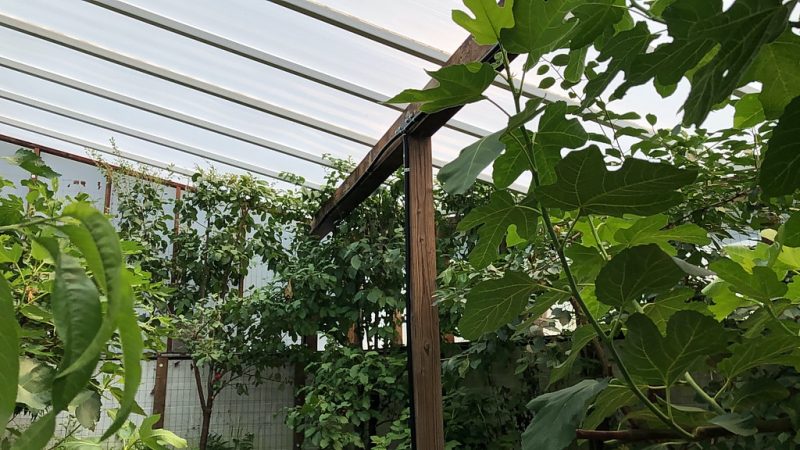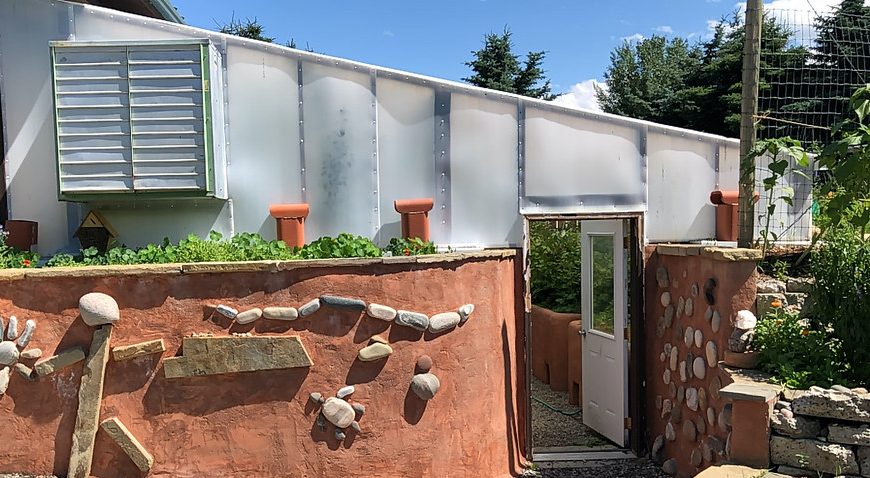Imagine a garden where tomatoes ripen in the heart of winter and fragrant herbs flourish against a backdrop of snow. The walipini, an underground greenhouse, offers just that—a chance to extend your growing season, come rain, snow, or shine.
What is a Walipini Greenhouse?

Derived from an Aymara word meaning “place of warmth,” the walipini utilizes the ground’s natural insulation to create a stable microclimate ideal for year-round gardening.
Unlike traditional greenhouses, which can get pricey and fragile, the walipini is an efficient and sustainable alternative. By harnessing the earth’s constant temperature, it maintains a warm and inviting environment even during freezing months. This earthy eco-system is not just an agricultural tool; it’s a nod to ancient ingenuity, blending environmental mindfulness with modern needs.
Considerations for Building a Walipini
Before breaking ground, several factors must be weighed to ensure your underground oasis thrives. Let’s walk through some critical elements to ponder:
Soil-Type
Your soil is more than just dirt; it’s the foundation of your walipini. Ideally, you’ll want a loamy soil type, which offers the perfect blend of sand, silt, and clay. This combination allows for good drainage while retaining enough moisture for your plants. Sandy soils dry out too quickly, while clay-heavy soils can become waterlogged, both of which could lead to root issues.
Conduct a soil test before you start digging. This will give you insights into its texture, pH, and nutrient content, helping you to amend the soil appropriately before planting. You might need to add organic matter or sand, depending on the results, to strike the right balance.
Water Flow
Nature abhors a vacuum, and when you dig into the earth, you’re altering natural water patterns. One critical aspect of building a walipini is ensuring proper drainage to prevent flooding. You’ll need to consider both surface water and groundwater.
Begin by assessing your site’s topography—prefer a slope for natural drainage. Incorporate French drains or swales around your greenhouse to channel excess water away. This thoughtful step saves you from potential disasters during heavy rains, keeping your plants high and dry.
Radon
Building underground isn’t just about keeping the warmth in; it’s also about keeping other, less desirable elements out. Radon, a radioactive gas found naturally in the earth, can seep into underground structures, posing health risks over time.
Do a radon test in your area before constructing your walipini. If results show elevated levels, consider sealing the structure’s base and using radon mitigation techniques, such as ventilation systems, to ensure a safe environment.
With these foundational ideas in place, you’re well on your way to crafting a cozy sanctuary that defies the seasons. As with any project, careful planning paves the way for success, ensuring your walipini becomes a cherished corner of abundance and growth.
Walipini Design and Construction
Building a walipini is a journey as much as it is a destination. The design and construction require a blend of practical planning and creative problem-solving, ensuring your underground greenhouse meets its potential. Here, we’ll guide you through the essential features and considerations:
Floor Level Drainage
As we discussed earlier, water management is vital. The floor of your walipini should be slightly sloped towards a designated drainage channel or trench. This simple design choice helps to prevent water from pooling around your plants, which is a lifesaver during unpredictable weather. By directing water to flow naturally out of the walipini, you maintain a dry and healthy environment for growing.
Bermed Back Side
Picture the back side of your walipini hugged snugly into the earth. This “berming” technique, where soil is piled against the structure, enhances insulation, protecting the interior from chilly winds and temperature swings. Typically, the bermed side is oriented towards the north (in the Northern Hemisphere) or the south (in the Southern Hemisphere) to shield from prevailing winds while maximizing solar gain on the opposite side.
Roof Angle to Catch Sun (and Divert Rain)
The roof is one of the most critical aspects of your walipini’s design. It should be angled to capture the most sunlight during winter, when the sun hangs low in the sky. Generally, a roof angle between 35 and 55 degrees is optimal, but this can vary based on your geographical location. Additionally, consider adding overhangs to divert rainwater, preventing excessive moisture from entering the greenhouse.
Underground Greenhouse Features
Venting
Even in winter, your underground paradise can overheat. Proper ventilation is key to regulating temperature and humidity. Install vents on the roof or at the top of walls to allow hot air to escape, ideally adjustable to control airflow. Passive vents or solar-powered fans can be very effective, offering a low-maintenance way to keep your plants comfortable.
Rain Collection Methods
Why let all that rain go to waste? Incorporating rainwater collection into your walipini design not only conserves this precious resource but also provides a sustainable irrigation option. Install gutters along the roof edge leading to a storage tank. From there, gravity or a simple pump can distribute water to your plants when needed, making the system both eco-friendly and cost-effective.
Growing Area
Inside the walipini, space planning is crucial. Create raised beds or rows for planting, leaving ample walking space for easy access to all plants. Paths can be mulched or paved with stones to reduce mud and make maintenance easier. Consider rotating crops seasonally to maintain soil health and maximize productivity.
Alternative Growing Methods
Don’t limit yourself to traditional soil planting. Depending on your interests and experience, explore alternative methods like hydroponics or aquaponics, which can thrive in a walipini. These systems offer high yields and efficiency, allowing you to diversify your planting options regardless of outside weather conditions.
Access
Your walipini should have easy, safe access. Consider incorporating a gentle ramp or stairs that lead down into the growing area. Ideally, the entrance should be wide enough for wheelbarrow access, making it easier to transport supplies and harvest.
The Benefits of Using a Walipini
Once your walipini is up and running, you’ll quickly begin to appreciate the unique benefits it offers. This underground greenhouse is not just about growing plants; it’s about transforming how you interact with your garden and the environment. Let’s take a look at some of the distinct advantages you can expect:
Better Temperature Control
One of the most striking features of a walipini is its ability to maintain stable temperatures. By tapping into the earth’s natural warmth, the walipini can sustain a consistent climate suitable for plant growth even when the weather above ground is harsh. This means your plants can thrive during cold winters and hot summers, reducing the stress of external weather conditions.
Unlike traditional greenhouses that can become heat traps during the day and lose heat quickly at night, the walipini keeps your garden comfortable around the clock. This stability not only promotes healthier plants but also extends your growing season by weeks or even months.
Less Panel Cleaning Maintenance
Anyone who has managed a traditional greenhouse knows the drudgery of cleaning panes. A walipini’s roof structure, often made of angled, clear materials like polycarbonate sheets or greenhouse-grade glass, naturally sheds dirt and debris more efficiently than vertical panels. This design reduces the frequency and effort required for cleaning, allowing more time to focus on nurturing your plants.
Moreover, with less surface area exposed to the elements, your structure stays cleaner longer—meaning the sunlight can do its job without being obstructed by layers of grime.
Less Wind Issues
Wind can be a gardener’s nemesis, tearing at structures, spreading weeds, and sapping the moisture from soil and plants alike. With its subterranean design, a walipini is less susceptible to wind damage. The earth itself acts as a natural windbreak, protecting your crops from harsh gusts that can lead to broken stems and eroded soil.
This protection extends beyond just physical damage; less wind also means reduced evaporation rates, keeping your plants hydrated with less frequent watering. The calm interior environment of a walipini fosters less stress and more growth potential for every leaf and stem within.
Opting for a walipini greenhouse means choosing a method that celebrates both environmental harmony and agricultural efficiency. As you nurture your garden within this unique structure, you’ll find a deeper connection with nature, enjoying bountiful harvests and peaceful gardening throughout the year. Whether you’re a seasoned green thumb or a budding enthusiast, the walipini offers a tangible way to create and sustain life, come what may.
Where Can I Find Plans for an Underground Greenhouse?

Embarking on the journey to build a walipini starts with having the right plan in hand. Fortunately, the gardening community is full of generous enthusiasts and experts who have shared their knowledge online. Here’s how you can get started with finding the perfect plans:
Online Gardening Forums and Communities: Websites like Permies and gardening subreddits are treasure troves of shared experiences and blueprints. Check out posts from veteran builders sharing their personal plans and learn from their trials and triumphs.
Dedicated Websites: A quick search can direct you to specialized sites that offer downloadable plans. Many offer detailed layouts, lists of required materials, and cost estimates, giving you a comprehensive view of what your project will entail.
Books and Publications: There are several books dedicated to year-round gardening and sustainable structures that include chapters on walipinis. These often provide in-depth insights, helping you tailor plans to fit your specific needs and climate conditions.
Materials
Gathering the right materials is crucial for the long-term success of your walipini. Although the specific requirements may vary based on your design, here are some common materials you’ll likely need:
Lumber and Timber: For constructing the frame and supporting structures of the roof.
Transparent Roofing Materials: Polycarbonate sheets or greenhouse-grade glass to allow maximum light entry.
Soil and Gravel: Used in the berming process and for drainage purposes.
Insulation Materials: Depending on your climate, additional insulation may be needed to maintain temperature stability.
Ventilation Components: Vents and fans to maintain air circulation.
Waterproof Membranes: These help in moisture control, especially if you’re building below the water table.
Procuring these materials from local sources not only reduces costs but also supports local businesses and reduces your project’s carbon footprint.
Inspiring and Step-by-Step Videos
Visual learners rejoice! There is a wealth of video content available that walks you through each step of building a walipini. Here’s how you can find some inspiring and educational videos:
YouTube Channels: Many homesteaders and sustainable living enthusiasts document their walipini projects on YouTube. Channels dedicated to permaculture, green living, and gardening offer series that show everything from site selection to final plantings.
Online Workshops and Webinars: Some organizations run webinars, and workshops focused on sustainable agriculture. These often include demonstration videos that provide practical insights and troubleshooting tips.
Social Media Platforms: Instagram and TikTok can be surprising sources of creative inspiration, showing short clips and time-lapses of construction processes, which might help simplify complex steps.
Harnessing these resources not only enriches your understanding but also connects you with a community of like-minded individuals eager to help and share their own learning curves. By seeing the process unfold through multiple perspectives, you can gain the confidence and knowledge to bring your own walipini vision to life.














